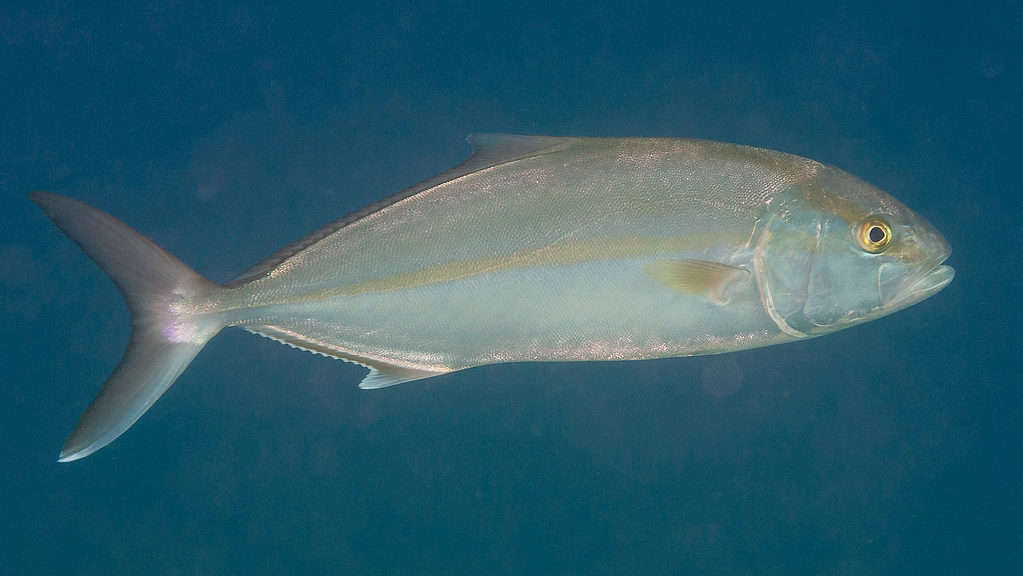Amberjack
Seriola
Amberjack can grow up to 200 pounds
Advertisement
Amberjack Scientific Classification
- Kingdom
- Animalia
- Phylum
- Chordata
- Class
- Actinopterygii
- Order
- Perciformes
- Family
- Carangidae
- Genus
- Seriola
- Scientific Name
- Seriola
Read our Complete Guide to Classification of Animals.
Amberjack Conservation Status
Amberjack Facts
- Prey
- Crabs, smaller fish
- Main Prey
- Crustaceans
- Group Behavior
- Solitary/School
- Fun Fact
- Amberjack can grow up to 200 pounds
- Most Distinctive Feature
- Large size
- Other Name(s)
- Medregal, Coronado
- Average Spawn Size
- Up to 59 million
- Habitat
- Ocean reefs and wrecks
- Predators
- Yellowfin tuna, sharks
- Diet
- Carnivore
- Lifestyle
- Solitary
- School
- Number Of Species
- 9
Amberjack Physical Characteristics
- Color
- Grey
- Yellow
- Silver
- Skin Type
- Scales
- Lifespan
- Up to 17 years
- Weight
- 40-200 pounds
- Length
- Up to 6 feet
- Age of Sexual Maturity
- 3-4 years
- Venomous
- No
- Aggression
- Low
View all of the Amberjack images!
If you want to try to catch a fish that is powerful as well as delicious, amberjack is a great option. These fish live in both the Atlantic and Pacific oceans and can be caught near reefs or wrecks, where they like to live. These fish can grow quite large, especially the largest species in the genus, the greater amberjack. They are a sustainable seafood option that is also tasty. If you enjoy yellowfin tuna, either in fishing or cooking, you should definitely try for amberjack.
5 Amberjack Facts
- There are nine species of amberjack within the genus.
- The largest species, the greater amberjack, can grow up to 200 pounds.
- These fish are popular in fish tacos and other dishes.
- Amberjacks live in the Pacific and Atlantic oceans.
- Juvenile amberjacks feed on algae and small organisms.
Amberjack Classification and Scientific Name
There are many species of amberjacks that live in both the Pacific and Atlantic Oceans. They all belong to the Seriola genus. There are nine species of amberjacks within the genus. These include:
- Guinean amberjack
- Greater amberjack
- Lesser amberjack
- Samson fish
- Yellowtail amberjack
- Fortune jack
- Japanese amberjack
- Banded rudderfish
- High-fin jack
They are all types of ray-finned fish and part of the Actinopterygii class. This means that their fins are supported by bones that look like rays, rather than more flexible cartilage. Within that class, amberjacks belong to the Carangidae family. Other members of this family include pompanos and other types of jacks. They are the largest in size within their family.
Amberjacks are part of the Carangiformes order. Many fish within this order are popular in sport fishing. Others, such as the Cobia and Dolphinfish, are also great to cook and eat. These fish belong to the Chordata phylum and Animalia kingdom.
Appearance

A greater amberjack has a darker strip down its back which darkens when under stress or when eating.
©Jesus Cobaleda/Shutterstock.com
Although each species varies slightly in appearance, amberjacks tend to be large, muscular fish. They can grow up to 6 feet long and weigh up to 200 pounds. Most are smaller, around 40 pounds, but still large and powerful. The greater amberjack is often heralded as one of the largest of the family and is popular in sports fishing. Fortunately, it is also a tasty fish to eat and makes a delicious meal. Females tend to be larger than males. This could be due to their tendency to live longer.
Greater amberjacks have a darker strip down their back. It deepens in color based on their mood, becoming more pronounced when they are under stress or when they are eating. They are usually dusky grey with a lighter silvery white belly. They are often the largest of the amberjacks.
As their name suggests, lesser amberjacks are smaller than the other species. They often top out at around 10 pounds. The other species range in size.
Distribution, Population, and Habitat
These fish live in both the Atlantic and Pacific, although not all species call both oceans home. The greater amberjack does live in the Atlantic and Pacific, making them a familiar sight for fishermen on both coasts. They tend to live deeper in the open ocean and require some specialized boating and fishing equipment to reel in.
When they are young, juveniles live near algae growths in the ocean that provide some protection as well as a source of food. They live in schools, although they dissipate as they mature and grow. Eventually, amberjacks go out on their own. Around 6 months of age, amberjacks move deeper into the ocean. They are found at depths between 60 and 240 feet. They are often seen around shipwrecks and reefs, where their food sources live.
Predators and Prey
When they are young, amberjacks eat plankton and other small organisms that they find in the algae where they live. As they grow, they begin to feed on small fish, crabs, and other marine life on reefs and shipwrecks. Like most species, they are plentiful where their food is located. When fishing for them, it is helpful to study the area first or go with a guide who knows where to find these interesting fish.
Because they are so large and powerful, not many predators can take on an amberjack. Larger fish, such as yellowfin tuna, and some seabirds will go after them. Sharks can also feast on both adults and young. Juveniles are more vulnerable to predators. Their algae home provides some protection. They also enjoy strength in numbers when they are young.
Reproduction and Lifespan of Amberjacks
Females spawn when they are fully mature, usually between 3 and 4 years old. They lay up to 59 million eggs each season. While not all eggs will hatch and mature into a new generation of fish, that is still a lot of babies! They hatch within 3-4 days and spend around one month as larvae. After hatching, they grow rapidly for their first 6 months of life, living in a school with other juvenile amberjacks. Greater amberjacks, one of the more common species, are yellow when they are young.
These fish can live up to 17 years, although closer to 10 is more common. They have been bred in captivity. However, they live and thrive in the wild. There was some history of overfishing but they are now considered a sustainable seafood choice due to their increasing numbers.
Amberjack in Fishing and Cooking

Japanese amberjack can be grilled, baked, or smoked.
©Mironov Vladimir/Shutterstock.com
Greater amberjacks are a popular fish for sport fishing, due to its size, muscular body, and location. Adults live in the open ocean and you will need a deep-sea fishing boat and gear to get them. In some areas, there is a specific season when you can fish for them. This protects them during spawning times and makes sure that the population is well-managed.
When cooking them, you can grill them, bake them, or even smoke them. They have firm white flesh and hold up well to marinades, sauces, and extra ingredients. One amberjack will result in many steaks so be ready to put some on ice for cooking later. They are a particularly great ingredient in fish tacos. Because they are common in the Gulf of Mexico as well as the Atlantic Ocean, they can be found on many menus in Florida.
Amberjack is higher in mercury than some other species of fish. Due to their large size and long lifespan, mercury can build up in their bodies. When you eat amberjack, this mercury is passed onto you. While they are still safe to eat, you may want to limit your consumption. This is especially important for pregnant and nursing women. You should consult your doctor if you have any concerns about the mercury content before eating this fish. They will likely provide serving recommendations that mirror those for tuna.
Related Animals
View all 194 animals that start with AAmberjack FAQs (Frequently Asked Questions)
Is Amberjack good to eat?
Yes, Amberjack is popular in cooking due to its mild flavor and firm flesh. It can be prone to some parasites, so make sure that you cook it thoroughly before eating.
What does Amberjack taste like?
Amberjack is similar to tuna and mahi-mahi, two other large fish. The flavor can be a bit stronger and richer than the ultra-mild mahi-mahi.
Does Amberjack have a lot of mercury?
Like tuna, Amberjack can be higher in mercury than some smaller fish. Mercury accumulates in the fish’s body during their long lifetime and can be passed onto you when you eat them. They are still safe to eat but you should follow recommendations for limiting your consumption if you have certain conditions or health concerns.
Thank you for reading! Have some feedback for us? Contact the AZ Animals editorial team.
Sources
- NOAA Fisheries, Available here: https://www.fisheries.noaa.gov/species/greater-amberjack
- University of Florida, Available here: https://blogs.ifas.ufl.edu/collierco/2020/04/29/amberjacks-a-complete-guide-of-what-you-need-to-know-before-the-season-opens/

















